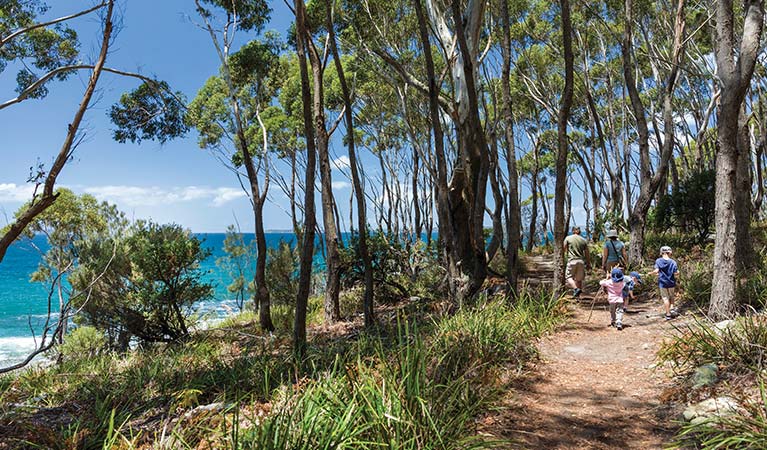Overview
Starting at Greenfield Beach picnic area, this short walk passes white sandy beaches and coastal forest by the shores of Jervis Bay. Stop for a swim, spot birds and dolphins, or extend your walk to Hyams Beach.
- Where
- Jervis Bay National Park in South Coast
- Distance
- 2.5km loop
- Time suggested
- 30min - 1hr 30min
- Grade
- Grade 3
- What to
bring - Hat, sunscreen, drinking water
- Please note
- Both tracks are easy but you’ll find the Scribbly Gum track steeper with more steps.
- If you'd like a slightly longer walk, try the path that goes from Chinamans Beach to Cyrus Street, which leads you to nearby Hyams Beach.
- There's also a council walking track north from Greenfield Beach that goes to Plantation Point via Blenheim Beach, and has several lookouts along the way. It makes a good extension to the national park tracks.
White Sands walk and Scribbly Gum track are interconnected walking tracks which loop through scenic Jervis Bay National Park.
Start White Sands walk at Greenfield Beach picnic area, or if you’d like a longer walk, you can start from Plantation Point to the north. From Greenfield Beach the track heads south along Jervis Bay, passing the white sands and clear water of Chinamans Beach. Remember to bring your swimsuit if you fancy a quick dip along the way.
You’ll be treated to incredible water views at various points along the track, which is a top spot for bird watching and glimpsing dolphins. There are also plenty of scenic detours along the way. From Chinamans Beach, you can walk to Cyrus Street and head through Hyams Beach town to reach its famous beach.
The return leg along Scribbly Gum track takes you away from the coastline, through tall coastal forest and woodland, finishing up at the top of Greenfield Beach picnic area. If you're lucky, you might spy some furry locals including possums and gliders.
Take a virtual tour of White Sands walk and Scribbly Gum track captured with Google Street View Trekker.
Map
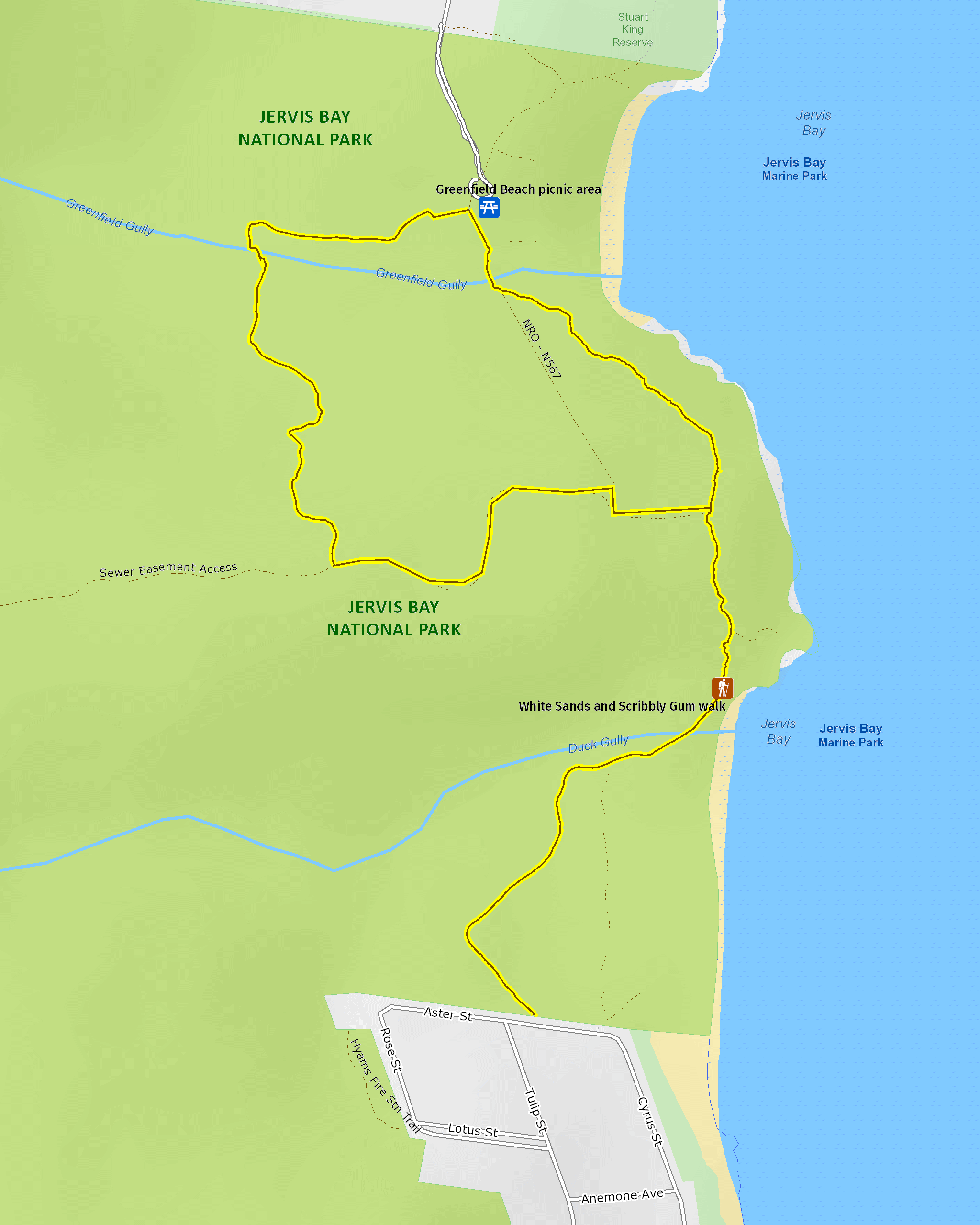
Map legend

Local alerts
For the latest updates on fires, closures and other alerts in this area, see https://www.nationalparks.nsw.gov.au/things-to-do/walking-tracks/white-sands-walk-and-scribbly-gum-track/local-alerts
General enquiries
- National Parks Contact Centre
- 7am to 7pm daily
- 1300 072 757 (13000 PARKS) for the cost of a local call within Australia excluding mobiles
- parks.info@environment.nsw.gov.au
Park info
- in Jervis Bay National Park in the South Coast region
Jervis Bay National Park is always open but may have to close at times due to poor weather or fire danger.
Visitor info
All the practical information you need to know about White Sands walk and Scribbly Gum track.
Track grading
Features of this track
Distance
2.5km loop
Time
30min - 1hr 30min
Quality of markings
Sign posted
Experience required
No experience required
Gradient
Short steep hills
Steps
Many steps
Quality of path
Formed track
Getting there and parking
Get driving directions
White Sands walk starts at Greenfield Beach picnic area. Pedestrian access to the picnic area opens directly off the cul-de-sac at the end of Elizabeth Drive, Vincentia.
- From the Princes Highway, take the Jervis Bay Road turn-off and follow signs to Vincentia
- Follow Elizabeth Drive to the cul-de-sac at its end – there are parking bays along the road
Parking
Parking is available on Elizabeth Drive, a short walk from Greenfield Beach picnic area.
Best times to visit
There are lots of great things waiting for you Jervis Bay National Park. Here are some of the highlights.
Spring
Take advantage of spring weather and head to Hyams Beach. You can pick up some fish and chips from the nearby Hyams Beach Café to enjoy on the white sands of this iconic south coast beach. If you're feeling energetic after lunch, walk the easy Hyams Beach trail.
Summer
Swim, surf, snorkel and dive your way through the summer school holidays in this beach paradise.
Winter
Humpback whales can be spotted migrating northwards in the winter months. Keep an eye out for southern right whales and dolphins too. They're often seen around the park's coastline.
Weather, temperature and rainfall
Summer temperature
Average
17°C and 24°C
Highest recorded
40.6°C
Winter temperature
Average
10°C and 17°C
Lowest recorded
-0.5°C
Rainfall
Wettest month
April, May and June
Driest month
September
The area’s highest recorded rainfall in one day
316.7mm
Maps and downloads
Prohibited
Fishing
Some of the waters around Jervis Bay National Park are protected areas within Jervis Bay Marine Park – fishing is prohibited in some areas. For more information, check the Marine Parks Authority website and the NSW Fisheries website.
Pets
Pets and domestic animals (other than certified assistance animals) are not permitted. Find out which regional parks allow dog walking and see the pets in parks policy for more information.
Smoking
NSW national parks are no smoking areas.
Learn more
White Sands walk and Scribbly Gum track is in Jervis Bay National Park. Here are just some of the reasons why this park is special:
Ancient connections
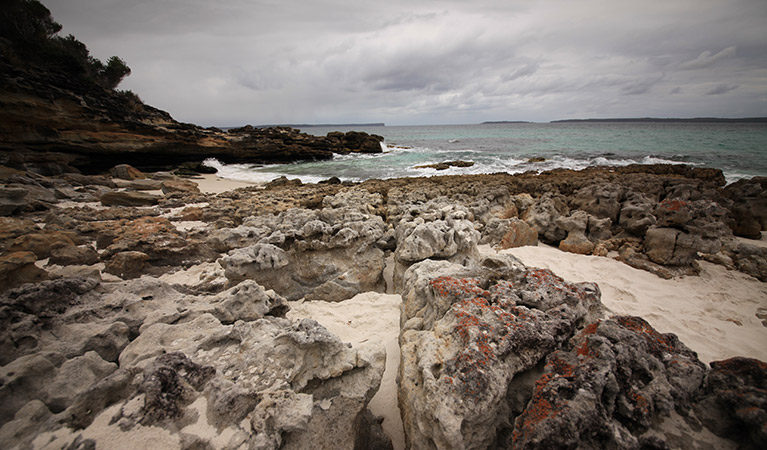
Jervis Bay sits within the lands of the South Coast (Yuin) Aboriginal people of the Dharawal-Dhurga language group. Research shows the area has the highest density and most diverse range of archaeological site types anywhere on the south coast, making this precious park an important place for the preservation of Aboriginal sites, like coastal middens, stone artefacts, rock art, and axegrinding grooves.
- Then and now: Aboriginal culture Then and now: Aboriginal culture is a Stage 3 (Years 5-6) school excursion at Jervis Bay National Park, focusing on HSIE. Through story and creative expression, the life and culture of the local people are shared.
- Then and now: Aboriginal culture Then and now: Aboriginal culture is a Stage 2 (Years 3-4) school excursion in Jervis Bay National Park, focusing on HSIE. Through story and creative expression, the life and culture of the local people are shared.
- Then and now: Aboriginal culture Aboriginal culture then and now is a Stage 1 (Years 1-2) school excursion in Jervis Bay National Park, focusing on Geography and History. Through story and creative expression, the life and culture of the local people are shared.
- Then and now: Aboriginal culture Then and now: Aboriginal culture is an Early Stage 1 (Kindergarten) school excursion in Jervis Bay National Park, focusing on HSIE. Through story and creative expression, the life and culture of the local people are shared.
Diverse habitats
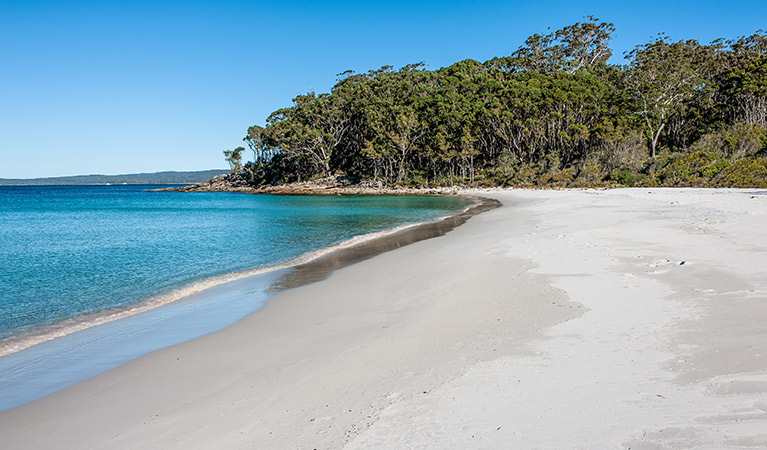
A walk through the park reveals its varied vegetation – from endangered bangalay sand forests to ubiquitous eucalypt woodlands. In the park’s protected gullies you’ll spot rainforest species like lilly pilly and water vine. And if you stop by Carama Inlet or Moona Moona creek, you’ll see saltmarsh and mangroves. Be ready to spot plenty of wildlife among coastal heathland on the sandstone plateau near Vincentia, as well as unique flora in the park’s northern clay-soiled heath.
Picture-perfect beaches

Arriving in this pristine haven, you could be forgiven for thinking you’re in paradise. The region's crystal clear waters and impossibly white sand are among its biggest drawcards – the sea is ideal for fishing, swimming and snorkelling. Be sure to enjoy a wander along Hyams Beach to experience its icing-sugarsand – it’s said to be the world’s whitest.
- Coonemia Creek Coonemia Creek in Jervis Bay National Park is a great spot for fishing, kayaking, birdwatching or a picnic.
- Greenfield Beach picnic area Greenfield Beach picnic area in Jervis Bay National Park is perfect for a barbecue. After a tasty lunch, go for a walk or head down to the beach for a swim or snorkel.
Protected birds
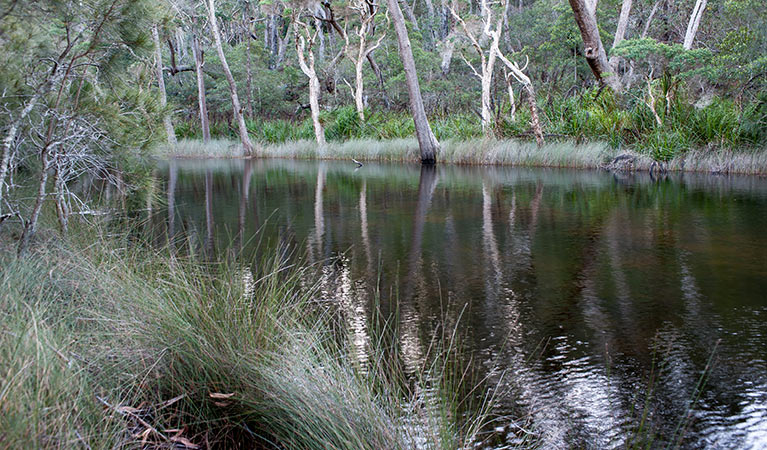
This gorgeous landscape is home to several threatened bird species that dependon the park for survival. The chance of seeing these special birds thriving makes the park a must for everyone, not just birdwatchers. Head to Lake Wollumboola to see waders and water birds or visit the heathland areas, which support eastern bristlebirds and ground parrots. You might see glossy black cockatoos among casuarina forest and powerful owls in woodland.
- Hyams Beach trail Hyams Beach trail, also known as the Bird Spotter’s walk is great for birdwatching in Jervis Bay National Park. Continue the walk to Seamans Beach for a refreshing swim, and loop back along Hyams Beach.
Plants and animals protected in this park
Animals
-

Yellow-tailed black cockatoo (Calyptorhynchus funereus)
The yellow-tailed black cockatoo is one of the largest species of parrot. With dusty-black plumage, they have a yellow tail and cheek patch. They’re easily spotted while bird watching, as they feed on seeds in native forests and pine plantations.
-

Sugar glider (Petaurus breviceps)
The sugar glider is a tree-dwelling Australian native marsupial, found in tall eucalypt forests and woodlands along eastern NSW. The nocturnal sugar glider feeds on insects and birds, and satisfies its sweet tooth with nectar and pollens.
-

Eastern ground parrot (Pezoporus wallicus wallicus)
The eastern ground parrot is a beautiful, ground-dwelling native bird that lives in low heathland habitat along the NSW North and South coasts and escarpments. It’s listed as a vulnerable species in NSW.
-

White-bellied sea eagle (Haliaeetus leucogaster)
White-bellied sea eagles can be easily identified by their white tail and dark grey wings. These raptors are often spotted cruising the coastal breezes throughout Australia, and make for some scenic bird watching. Powerful Australian birds of prey, they are known to mate for life, and return each year to the same nest to breed.
-

Australian pelican (Pelecanus conspicillatus)
The curious pelican is Australia’s largest flying bird and has the longest bill of any bird in the world. These Australian birds are found throughout Australian waterways and the pelican uses its throat pouch to trawl for fish. Pelicans breed all year round, congregating in large colonies on secluded beaches and islands.
Plants
-

Black sheoak (Allocasuarina littoralis)
The black sheoak is one of a number of casuarina species found across the east coast of Australia and nearby tablelands. Growing to a height of 5-15m, these hardy Australian native plants can survive in poor or sandy soils. The barrel-shaped cone of the black sheoak grows to 10-30mm long.
-

Scribbly gum (Eucalyptus haemastoma)
Easily identifiable Australian native plants, scribbly gum trees are found throughout NSW coastal plains and hills in the Sydney region. The most distinctive features of this eucalypt are the ‘scribbles’ made by moth larva as it tunnels between the layers of bark.

